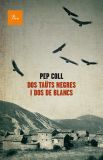New Spanish Books: The online guide of titles from Spanish publishers and literary agents with rights for translation in the UK. To consult titles available in other markets please click on the above links.
Dos taüts negres i dos de blancs

The massacre of a family of farm labourers in Carreu in 1943 shakes the local community and surrounding villages of this corner of Pallars Jussà, Catalonia. But news of the mass murder did not get much further. In an age when it was necessary to offer an image of Spain as a peaceful paradise, censorship silences the press. Seventy years later, Pep Coll investigates the secrets of that terrible event that marked his childhood in the small mountain town of Pessonada. At first glance, the story is very similar to Truman Capote's famous account of the killing in Kansas, but the consequences of the Pillars murder were diametrically opposed to those portrayed in In Cold Blood: the press ignored the case, and Franco's judiciary either was unable or had no interest in solving it. Based on the stories of the real-life characters involved in the case, Pep Coll offers an exceptionally convincing and absorbing novel.
All panellists agreed “Dos taüts negres I dos de blancs” is a highly atmospheric novel which has good potential to work very well in the UK.
Dos taüts negres i dos de blancs is a novel which fictionally reconstructs a crime which took place in Pallars Jussa, in the Catalan Pyrenees in 1943. In a rural community of people working on and living off the land, the brutal murder of a family, a mother, father and two young daughters, shocked everybody who knew them. However the crime became significant due to the fact that it remains unsolved to this day; at the time, despite the brutal nature of the crime, it went largely unreported because of the heavy censorship of the press that strived to maintain the idealistic vision of the “nueva España” and, due to the social and political circumstances at the time, nobody was ever found guilty of the crime. (…)
The structure of the novel is one that is used to great effect. As each character provides an account of the crime or the circumstances relating to it, the plot is moved on a stage. (…)
(…) it is a fascinating insight into how such a major event could be so insignificant to such a large number of people. The novel offers a complete picture of rural life, with its traditions and peculiarities and, as it spans a time of almost 50 years, also explores the changes that both the people and the land underwent in the second half of the 20th century. In terms of translation for an English speaking audience I think it fits fairly well into recent trends for both historically based novels and murder mystery fiction.
The mixture of fact and fiction is used to excellent effect and I would highly recommend this slice of 20th century Pyrenean life. (From the reader report by Jennifer Arnold)
